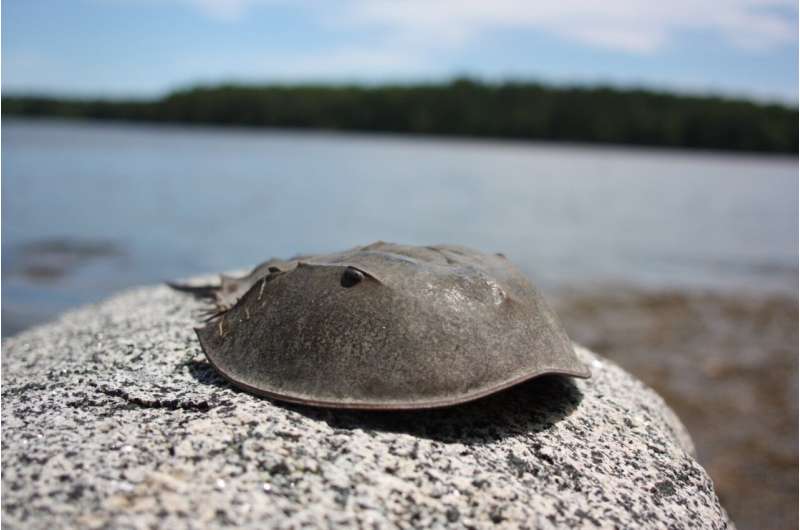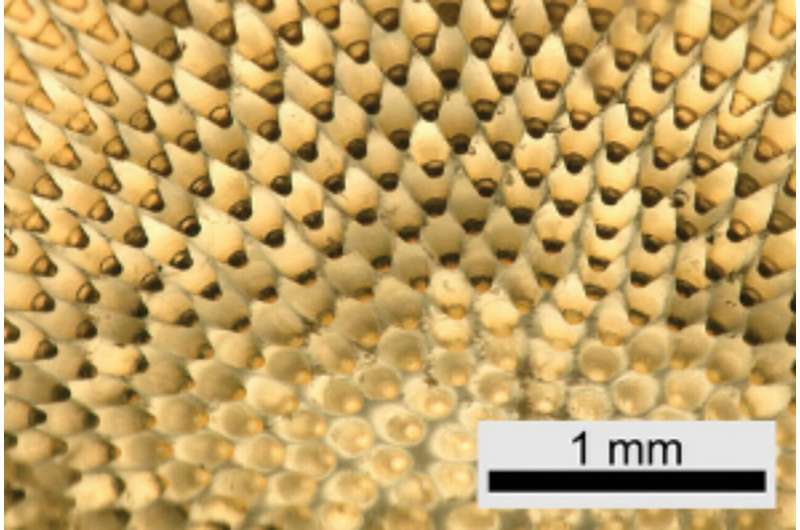Adaptations across scales: Scientists learn how the horseshoe crab sees through its cuticle lenses

The primitive compound eyes of a horseshoe crab are one the largest to be found in nature. In contrast to many insects and spiders that build their eyes from glassy proteins, the horseshoe crab uses cuticle, the same material that builds its skin and legs.
An international team led by Prof. Yael Politi from the B CUBE–Center for Molecular Bioengineering at TU Dresden has now showed that a host of different changes in the overall architecture as well as the local composition of the material allow the animal to use cuticle to build optical elements. The results were published in the journal Advanced Science.
Compound eyes are common in insects and crustaceans. They consist of an array of lenses that collect light from different directions and focus it precisely in one spot, where the receptor cells are located. "The compound eye is nature's answer to the need of capturing a wide field of view in an otherwise small eye. It's a similar challenge to that faced by modern camera designers who want to further and further miniaturize the cameras while keeping a wide field of view of above 90 degrees" explains Prof. Yael Politi, research group leader at the B CUBE–Center for Molecular Bioengineering at TU Dresden.
The compound eyes of the horseshoe crab are primitive in comparison to other arthropods, like dragonflies or shrimp. Instead of using the typical glassy proteins to build the lens, the horseshoe crab repurposes the material that builds its exoskeleton—the cuticle. "The arthropod cuticle is a composite material consisting of proteins and a crystalline polymer known as chitin. It is the characteristic component of insects, spiders, and other arthropods who use it to build their skin and legs, the so-called exoskeleton," says Prof. Politi.
The cuticle is known for its versatility and outstanding mechanical features. There is not one cuticle though. Different arthropods adjust the composite to their needs. During evolution, the structure of the material adapted to its function and became stiffer or more flexible, depending on the needs of individual animals. "Nevertheless, using cuticle to build lenses is unusual and the extent to which the horseshoe crab repurposes it for its eyes is nothing short of remarkable," says Prof. Politi.
"We wanted to understand exactly how the animal modified the structure and composition of the cuticle, a material mostly known for its outstanding mechanical features, to build an array of lenses with variable optical properties," adds Prof. Politi.

Adapting the cuticle into an optical element
The team worked together with researchers from Potsdam and Brno and used large-scale European synchrotron radiation facilities to analyze the lenses of the horseshoe crab. The researchers looked both at the global organization of the cuticle layers, as well as the ratio of the individual components, the water content, and the elemental composition of the material. As a result, they found a variety of adaptations that together allow the cuticle to become an excellent optical element.
"Working at the European Synchrotron Radiation Facility in Grenoble and BESSY II Light Source in Berlin allowed us to use synchrotrons and their very small focused light beams to perform X-ray diffraction and fluorescence. Thanks to these techniques, we were able to map the molecular structure of the cuticle components at different length scales and to find out what chemical elements are used to build this particular version of the cuticle," explains Oliver Spaeker, Ph.D. student at the Max Planck Institute of Colloids and Interfaces in Potsdam and the main author of the study.
The researchers also developed a new method to measure the optical properties of the material at high resolution. For this, they collaborated with the Czech company Telight and used quantitative phase imaging. The new method allowed to correlate the local structure of the material with the optical properties in that particular part of the lens.
Taken together, the team found not one but a host of adaptations at all levels that allow the horseshoe crab to use cuticle for optical elements. "Everything from the local composition of the cuticle, in particular the addition of Bromine, to multiple changes in the architecture of the composite, i.e., the ratio between its components, organization of the proteins, the varying water content, and the overall shape of the lens… It all contributes to making cuticle into a material with excellent optical properties," says Prof. Politi.
"What surprised us, in the end, the most was that the cuticle lenses seem to work so well that the animal needed to introduce pigments to actually reduce the amount of light that is collected by the lens," adds Prof. Politi.
The research group aims to extract design principles from biomaterials. "My research group aims to learn from nature—the oldest and most experienced iterative designer in the world, working under the constraints of evolution" says Prof. Politi. In the long run, such insights can be used to produce better materials that are less complex and are easier to recycle, while performing at least as good as they need to.
More information: Oliver Spaeker et al, Gradients of Orientation, Composition, and Hydration of Proteins for Efficient Light Collection by the Cornea of the Horseshoe Crab, Advanced Science (2022). DOI: 10.1002/advs.202203371
Journal information: Advanced Science
Provided by Dresden University of Technology





















